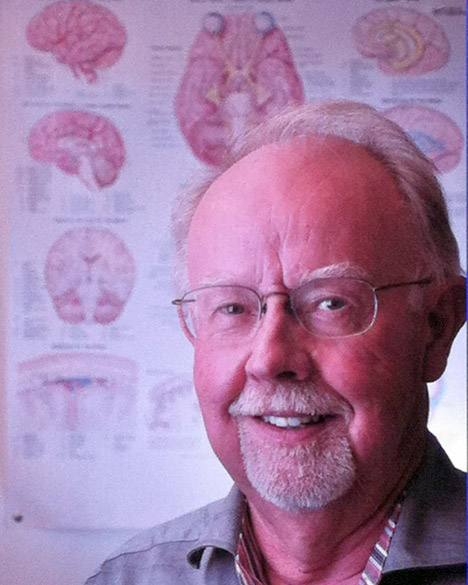Nicholas W. Seeds, PhD
Professor Emeritus

Ph.D., University of Iowa
Contact Information
Phone: (303) 724-3123
E-mail: [email protected]
After studying the involvement of extracellular proteases in aspects of axonal growth and cell migration in the developing nervous system for a number of years, we have turned our focus more recently to roles the extracellular protease plasminogen activator plays in synaptic plasticity associated with learning & memory and in neural regenerative events leading to recovery of function following spinal cord injury. We have shown that tissue plasminogen activator (tPA) activity is required for cerebellar motor learning, where it is thought to play a role in synaptic activity. Furthermore, tPA activity is dramatically inhibited in the Alzheimer Disease brain by elevated levels of a specific tPA-inhibitor called neuroserpin. Using mice carrying a mutant human amyloid precursor protein (APP) that develop amyloid plaques and show a spatial learning deficit, we have restored normal behavior by deleting the neuroserpin gene. Current studies are directed at identifying the mechanisms that up-regulate neuroserpin in the AD brain, and developing inhibitors of neuroserpin as potential therapeutics. Following injury to the peripheral or central nervous system, plasminogen activators are induced in an attempt to re-establish neuron – neuron connections. Our studies focus on the role urokinase plasminogen activator (uPA) induction, following a C2 spinal cord injury, plays in promoting new and more active synaptic connections in the phrenic motor nucleus that lead to a recovery of diaphragm activity and restore breathing. Similarly, we are studying the regenerative role of tPA for axon re-growth across an injury site in the spinal cord dorsal column.
Seeds, N.W., B. Williams and P. Bickford (1995). Cerebellar motor learning induces tissue plasminogen activator expression in Purkinje neurons. Science 270, 1992-1994 .
Hayden, S.M. and N.W. Seeds (1996). Modulated expression of plasminogen activator system components in cultured cells from dissociated mouse dorsal root ganglia. J. Neuroscience 16, 2307-2317.
Thewke, D. and N.W. Seeds (1996). Expression of hepatocyte growth factor/scatter factor, its receptor c-met and tissue plasminogen activator in the developing olfactory system. J. Neuroscience 16, 6933-6944.
Seeds, N.W., L. Siconolfi and S. Haffke (1997). Neuronal extracellular proteases facilitate cell migration, axonal growth and pathfinding. Cell & Tissue Res. 290, 367-370.
Thewke, D, and N.W. Seeds (1998). Expression of mRNAs for HGF/SF, c-met, and tPA show a systematic relationship in the developing and adult cerebral cortex and hippocampus. Brain Res. 821, 356-367.
Seeds, N.W., S. Haffke and M. Basham (1999). Neuronal migration is retarded in mice lacking the tissue plasminogen activator gene. Proc. Nat. Acad. Sci. USA 96, 14118-14123.
Tabrizi, P., L. Wang, N.W. Seeds, et al. (1999). tPA deficiency exacerbates cerebrovascular fibrin deposition and brain injury in a murine stroke model. Atheroscl. Thromb. & Vasc. Biol. 19, 2801-2806.
Seeds, N.W., S.P. Haffke and M.E. Basham (1999). Neuronal migration is retarded in mice lacking the tissue plasminogen activator gene. Proc. Nat. Acad. Sci. USA 96, 14118-14123.
Basham, M.E. and N.W. Seeds (2001). Plasminogen gene expression in neonatal and adult brain regions. J. Neurochem. 77, 318-325.
Siconolfi, L.B. and N.W. Seeds (2001). Induction of the plasminogen activator system accompanies peripheral nerve regeneration after sciatic nerve. J. Neurosci. 21, 4336-4347.
Siconolfi, L.B. and N.W. Seeds (2001). Mice lacking tPA, uPA, or plasminogen genes show delayed functional recovery after sciatic nerve crush. J. Neurosci. 21, 4348-4355.
Siconolfi, L.B. and N.W. Seeds (2003). Mice lacking tPA and uPA genes show attenuated matrix metalloproteases activity after sciatic nerve crush. J. Neurosci. Res. 74, 430-434.
Seeds, N.W., M.E. Basham and J.E. Ferguson (2003). Absence of tissue plasminogen activator gene or activity impairs mouse cerebellar motor learning. J. Neurosci. 23, 7368-7375.
Minor, K.H., L.K. Akison, H.G. Goshgarian and N.W. Seeds (2006). Spinal cord injury-induced plasticity in mouse – The crossed phrenic phenomenon. Exp. Neurol. 200, 485-494.
Minor, K.H. and N.W. Seeds (2008). Plasminogen activator induction facilitates functional recovery of respiratory function following spinal cord injury. Mol. Cell. Neurosci. 37, 143-152
Minor, K.H., J. Phillips and N.W. Seeds (2009). Tissue plasminogen activator promotes axonal outgrowth on CNS myelin after conditioned injury. J.Neurochem. 109,706-715
Fabbro, S. and N.W. Seeds (2009). Plasminogen activator activity is inhibited while neuroserpin is up-regulated in the Alzheimer disease brain. J.Neurochem. 109, 303-315
Seeds, N.W., L.K. Akison and K.H. Minor (2009). Role of plasminogen activator in spinal cord remodeling after spinal cord injury. Respir. Physiol. Neurobiol. 169, 141-149
Fabbro, S., K. Schaller and N.W. Seeds (2011). Amyloid-beta levels are significantly reduced and spatial memory defects are rescued in a novel deficient Alzheimer’s disease transgenic mouse model. J.Neurochem. 118, 928-938.
Seeds, N.W., S. Mikesell, R. Vest, T. Bugge, K. Schaller, and K. Minor (2011). Plasminogen activator promotes recovery following spinal cord injury. Cell. Mol. Neurobiol. 31, 961-967.
Subhadra, B., K. Schaller and N.W. Seeds (2013). Neuroserpin up-regulation in the Alzheimer’s disease brain is associated with elevated thyroid hormone receptor-β1 and HuD expression. Neurochem. Internat. 63, 476-481.
Please see PubMed for a complete listing of publications.